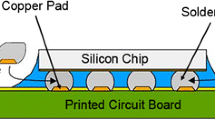Conclusions
-
1.
High-temperature steels and alloys fracture in soldering by a brittle mechanism (this is the most typical for dispersion-hardening alloys).
-
2.
An elevated sensitivity of dispersion-hardening alloys to the action of molten solder is observed in a specific temperature range where their plasticity falls abruptly upon heating.
-
3.
In soldering structures by copper-silver solders, such factors as the multiphase structure, the grain sized>0.1 mm, the duration of contact with the melt, the hydrogen content exceeding 3×10−4 wt.%, the low-melting elements Pb, S, and Sn, the mechanical strength concentrators (sealing flanges), and the growth of the deformation rate enhance the embrittlement of the materials, whereas a barrier coating possessing a chemical affinity for the solder weakens it. The scale factor virtually does not affect the degree of embrittlement.
-
4.
Upon the interaction between the material and the molten melt, the overstress and the rate of fracture become enhanced and the activation energy and the fracture toughness diminish. These changes are more typical for dispersion-hardening alloys than for steels and homogeneous alloys.
Similar content being viewed by others
References
V. N. Semenov, A. I. Chernitsyn, and V. V. Sagalovich, “Effect of the structure of alloy ÉP202 on the susceptibility to cracking in soldering,”Svar. Proizv., No. 12, 33–35 (1975).
V. N. Semenov,Liquid-Metal Embrittlement of High-Strength Alloys in Their Interaction with Copper-Silver Solder and the LPRE Soldering Technology, Author's Abstract of Candidate's Thesis [in Russian], Moscow (1987).
S. N. Zhurkov and É. I. Tomashevskii,Zh. Tekh. Fiz.,25(66) (1955).
Additional information
Translated from Metallovedenie i Termicheskaya Obrabotka Metallov, No. 10, pp. 6–12, October, 1999.
Rights and permissions
About this article
Cite this article
Semenov, V.N. Effect of copper-silver solder melt on the properties of high-strength and high-temperature alloys and steels. Met Sci Heat Treat 41, 426–433 (1999). https://doi.org/10.1007/BF02469092
Issue Date:
DOI: https://doi.org/10.1007/BF02469092




